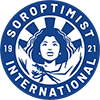How it all started
Dublin-born Stuart Morrow, who emigrated to California in 1885, was responsible for forming Rotary clubs in the UK ( Paul Harris who was responsible for Rotary International). Morrow went on to form the world’s first Soroptimist Club in 1921.
While attempting to form a male ‘Optimist Club’ in Oakland, USA, he called upon the Parker-Goddard Secretarial School in search of a candidate for membership, presuming that the school was run by two men. On learning that is was operated by women, he sought to excuse himself, but one of the principals, Adelaide Goddard, commented, “When the men admit women as members of their service clubs, I would be interested.”
This remark sparked an idea for Morrow. He called together several of the outstanding business women in Oakland to pursue the idea of forming a club for women, and the Articles of Incorporation of that first Soroptimist Club, with Adelaide Goddard as one of its founder members, were filed by Morrow in 1921. The chosen name – SOROPTIMIST – was coined from two Latin words: SOROR and OPTIMUS. Soror – Sister: symbol of the bond of comrades. Optimus – the best: the highest good. Hence it became known as “The Best for Women”.
When first organised, the Soroptimists met as a luncheon or friendship club – but not for long. SERVICE was felt to be the key word for Soroptimists, and has remained so ever since; indeed, Soroptimist International is now the largest women’s service organisation in the world.
The idea of Soroptimism grew rapidly. Morrow travelled widely; his vision, to form an international Soroptimist organisation. In 1924 he organised the Paris and the Greater London clubs, the latter’s charter-meeting being attended by over 250, including members of the Royal family. On St Valentine’s Day, 2009, the Greater London club was 85.
Stuart Morrow made his living from chartering service clubs and worked for many organisations. He charged a fee to charter every club and a percentage of the annual dues for each member. He owned the corporation which chartered Soroptimist. In 1927 SI purchased the rights in the Corporation and the name ‘Soroptimist’ from him for $5,500.
Today, Soroptimist International has come a very long way from that first vision of Stuart Morrow’s ‘friendship’ clubs. Soroptimist International now has Consultative Status at the United Nations and accreditation with many bodies, including the UN High Commission for Refugees and The UN Environmental Programme. It also has representatives on a large number of organisations, amongst which are UNICEF, Landmine Action, The Status of Women Commission and the Human Rights Commission.
A man might well have started this movement 90 years ago, but its female members immediately saw the potential and have taken it forward into an organisation which enjoys international standing and immense respect around the world.
Soroptimist International’s website can be accessed at:


